![]() Despite limited operational installations, the current ‘Remote Tower’ concept has been around for many years. It is one of the most hyped concepts to enter the ATM arena in the last few years and has made stars out of ANSP and industrial suppliers who, until then, will openly admit to being much further from the spotlight.
Despite limited operational installations, the current ‘Remote Tower’ concept has been around for many years. It is one of the most hyped concepts to enter the ATM arena in the last few years and has made stars out of ANSP and industrial suppliers who, until then, will openly admit to being much further from the spotlight.
Think Research has been involved since the start of the current wave of projects mostly emanating from SESAR and mostly in northern Europe although our experiences there are mirrored in our involvement further afield. We wrote the operational concept for LFV, helped Avinor with their procurement and even won an award for our “Outstanding Contribution” in Remote Tower standards.
So, before most of the systems in development are even implemented, why are we saying that it is time to move on from Remote Tower?
What’s Next for Remote Tower?
The original Remote Tower concept was developed to align to a specific operational framework, set of technologies and regulations. LFV achieved the world’s first Remote Tower Centre by playing within the existing rules and replicating a traditional tower out-the-window view. It was the first one most of the industry had seen so it has become the standard.
But we now feel that the accepted framework is limiting the growth of the concept and is no longer fully representative of what the concept has become. The current model was selected for a reason, but the concept has now grown such that this model no longer provides a clear and coherent description of what the wider concept actually is, and there is a danger that the concept continues to grow, but without the conceptual framework to fully support it.
A higher level concept – for the sake of this article let’s call it Digital Aerodrome Services (D-ATS) – should be proposed to allow Remote Tower to expand
D-ATS takes a more holistic approach towards thinking about ways to provide aerodrome traffic services and allows for growth of the concept. It does so by placing a number of core conceptual themes at the centre of an adaptable framework, these core themes act as the building blocks or ‘DNA’ which then feed out to every operational implementation and technical enabler. This framework does not seek to ‘re-brand’ or change the Remote Tower concept in any way, instead it suggests that Remote Tower is part of a wider, more far-reaching, concept with many more use cases.
The Existing Concept of Remote Tower
In order to understand the need to define the D-ATS concept it is important to appreciate the origins of the Remote Tower concept.
Remote Tower was developed for a particular set of use cases, predominantly small airports in Scandinavia driven by specific requirements (technological, political, operational and otherwise). The concept which emerged 10 years ago was geared towards describing the scope of this new concept within these confines, and at the time the full potential of the concept was not yet fully understood.
The framework which is commonly used to defined Remote Tower uses three distinct applications based on operational use case: Single, Multiple and Contingency. Single operation refers to the provision of the ATS of one aerodrome by remote ATCO(s), it is typically considered as a permanent replacement to the existing control tower. Multiple operation is similar, but instead the ATCO will control multiple aerodromes simultaneously and as such this reflects a significant change to current operating methods. Contingency operation refers to the temporary provision of ATS in cases where the permanent ATS facility is unusable.
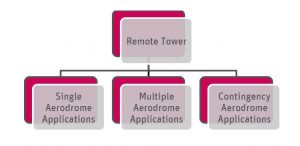
Initially these three concept areas were seen as being distinct and with a well-defined scope. Over time, and due to natural concept evolution, scope creep occurred. This caused the line between each distinct concept area to blur, subsets emerged and complex alternatives which didn’t align to the existing framework started to appear.
As the Remote Tower concept evolved the operational framework surrounding it shifted and expanded in an attempt to provide stakeholders with a well-defined and usable concept which could be easily navigated.
An easy way to appreciate the ways that the existing framework has attempted to adapt is to look at the changing terminology used when discussing and documenting the Remote Tower concept. The primary example is the use of the word “remote”. The ability to provide ATS at a location remote from the local airport was the primary driver for many of the initial use cases, these being based around small aerodromes in remote communities. As such the original operational concept was developed with these use cases in mind. However, it is now clear that the technologies which enabled remote ATS to be provided are also enablers for various other benefits to be gained both on the aerodrome site and also within the existing conventional tower control room itself. In fact, when considering the various drivers for implementing the technologies associated with Remote Tower, it is clear that in the majority of cases the “Remote Tower” solution implemented will in fact be far from Remote.
Take the example of a medium-sized airport operating at medium capacity, but which requires a contingency facility due to the importance of the airport to the network. To simply choose a ‘typical’ Remote Tower solution would most likely result in a fully certified optical representation system, at vast expense. In fact, all that may be required is a surveillance display system capable of supporting a temporary procedural service. The current concept definition does not make room for such applications due to the close alignment between concept definition and technical solution.
Rather than try to expand and shift the existing framework that the Remote Tower concept has been created around, it has now reached a point where it is clear that Remote Tower is only one subset of a wider concept – Digital Aerodrome Traffic Services (D-ATS).
The Story of D-ATS
The story of D-ATS starts right at the roots of the original Remote Tower concept- we know why we need D-ATS, but what is it?
Does it replace Remote Tower? And how do we navigate through it? In order to start answering some of these questions we must go back to the beginning and ask: what actually is Remote Tower? At a conceptual level, if not the whole concept, where does it fit? and what makes it up?
Originally we thought of Remote Tower as being at the centre of the ‘Remote Tower tree’ feeding out to various ‘subspecies’ which were all descendants of the concept. Over the past years however, we’ve realised that Remote tower is itself a subspecies of a much wider concept.
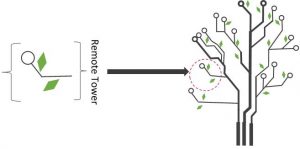
We thought we were looking at the whole tree – turns out it was just a branch of a much larger, more far-reaching tree.
A fundamental question need to be asked- “what is the remote tower concept”- we all know what Remote Tower does, but the concept has grown so rapidly in recent years and months that this has become a much more difficult question to answer. Much like finding out about a newly discovered species by decoding the genome and sequencing the DNA, the Remote Tower concept has been broken down and analysed at a lower level to identify what core ideas make it up and how those could apply to a wider concept.
What is Remote Tower made of? Remote Tower started life simply as the idea of remotely providing an air traffic service to an aerodrome with the primary aim of reducing cost. Cost efficiency is therefore the most obvious building block of the concept: what performance improvement is required?
The use of technology is another important consideration- does this specific solution rely heavily on advanced technology to support it? Traditionally the remote tower we have all become familiar with seeing does indeed rely on advanced optical presentation systems, but does it have to? There are many potential applications which fall under this wider concept which do not involve such technology. The question is therefore: What technological improvement to the Aerodrome ATS is required?
The operating environment is an important consideration; Does the Remote Tower need to service many small aerodromes in a sparsely populated country each with few movements or does it facilitate the operation of 1 small aerodrome or a new apron at a much larger international airport? Is it Remote at all? What operating environment will the solution operate in?
Flexibility is a key quality of any new air traffic operation particularly for en-route operations. Until Remote Tower however this flexibility has been limited to large operations rooms serving many sectors. For a small, local, insulated Aerodrome traffic service flexibility is much more difficult to achieve. Manning a small aerodrome out-of-hours becomes more difficult when requiring a team of ATCOs and support staff to remain in the tower to support just one or two movements, possibly hours apart. The cost involved in doing so may also be prohibitively expensive for some operators. The key question is therefore: what flexibility is required – Operational, technological or otherwise?
There are many air traffic systems in operation which a new Aerodrome traffic service may have to interface with- Which ATS systems, and airport systems, must the new Aerodrome traffic service integrate with?
All these questions make up the ‘DNA’ of the concept and may describe a Remote Tower but may also describe a contingency solution or a ‘digital upgrade’ of a traditional tower, or another possible implementation. In case you haven’t followed the analogy so far, these solutions are ‘leaves’, or nodes, growing on branches of the ‘DATS’ tree.
The answers to these questions are the ‘genes’ of the concept, a series of questions which should be asked by an airport thinking of implementing such a solution, the answers to which will make up the unique genes of your specific solution.
By ‘decoding’ the DNA of Remote Tower in this way the fundamental building blocks of the wider D-ATS concept have been identified. We can start to build this concept using these building blocks. Much like taking a leaf from the tree, we can break it down into its fundamental components to work out what tree it came from.
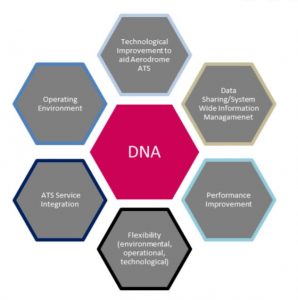
The relationship between the concept, the ‘DNA’ and the enablers is shown in the diagram above. The D-ATS ‘tree of life’ sits at the centre, branching out to more specific implementations, each of which maps to its specific enablers. These surrounding enablers are split into six categories- remember the six genes we decoded? This is where they come in; each gene has associated enablers/descriptions for example: Operational environment splits down into airport complexity, Airspace complexity and Airport capacity and each describes an aspect of the environment. Similarly, a number of potential technological enablers are contained in the ‘ Technological improvement’ gene. Is this a complete concept? Absolutely not. The main purpose of this framework is to allow the concept to grow, as it continues to evolve many more enablers and branches will be discovered which will simply slot into the jigsaw.
How do I navigate through this concept?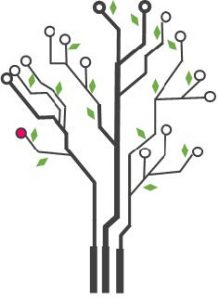
Think of the genes as a series of questions: what environment do I need my D – ATS to operate in? What benefit do I need it to bring?
etc. The answers to these questions will lead to the unique ‘genes’ of your D-ATS, a new node on the D-ATS tree. Depending on the answers to these questions, the new implementation will fit onto a specific branch- or maybe lead to a completely new branch.
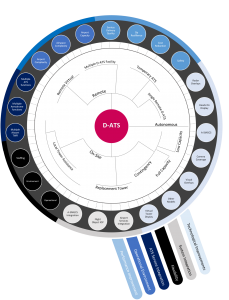
For example, a contingency solution may look like the below: a solution which must provide operational flexibility and increased operational resilience at a large airport, with a focus on A-SMGCS and airport services integration. Notice that not each ‘gene’ is of equal importance and some may contain multiple enablers or criteria.
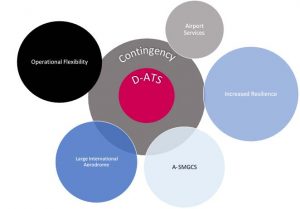
Is Remote Tower Extinct?
It should be evident by now that this concept in no way seeks to re-brand Remote Tower or change what it provides. Remote Tower has, however, evolved. It has in fact evolved so much so that we realised we were no longer looking at the whole concept. We needed to take a step back and look at the wider picture in order to discover the higher-level concept. So no, Remote Tower is as alive as ever, but only as a leaf on the D-ATS tree. The tree continues to evolve as well, producing more and more branches of Aerodrome ATS, each full of nodes (or specific D-ATS solutions- if you haven’t followed the analogy this far!).
It is often said that Remote Tower is a ‘revolution’ in the world of air traffic control, this is completely true. The revolution has happened and we now have an exciting, dynamic and constantly evolving way of providing air traffic services at aerodromes. This is a technology-driven concept which must be allowed to grow and evolve outside its original boundaries.
The key point is that growing the entire D-ATS concept inside the existing Remote Tower framework will result in a Remote Tower shaped D-ATS; instead Remote Tower must be allowed to grow inside a D-ATS framework which provides room for growth in all directions and the formation of brand new concepts
Click here to find out more about our expertise in this area.


Recent Comments